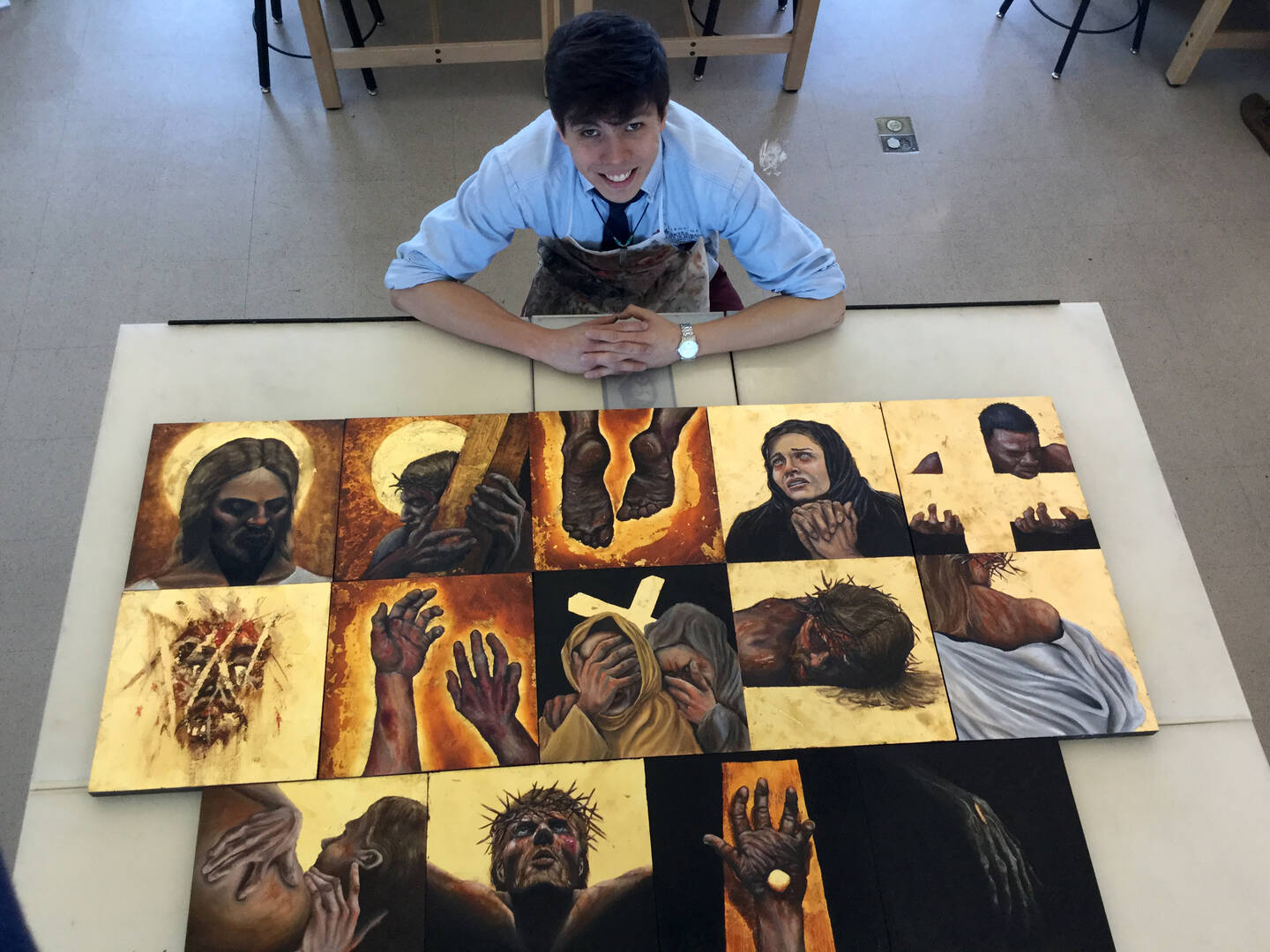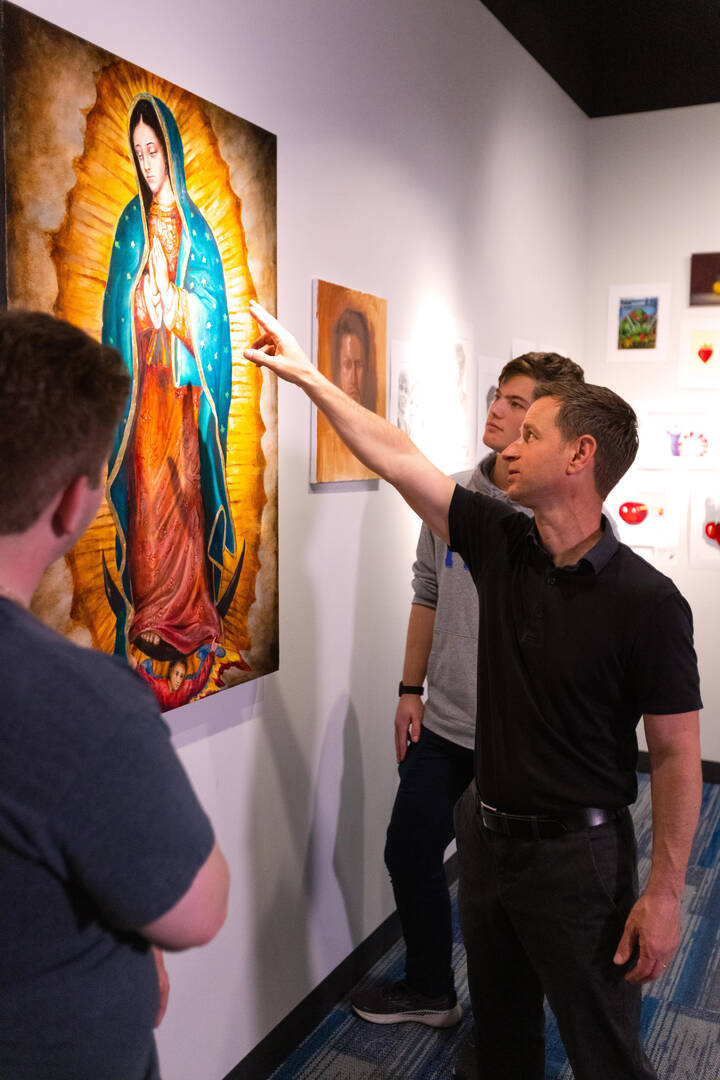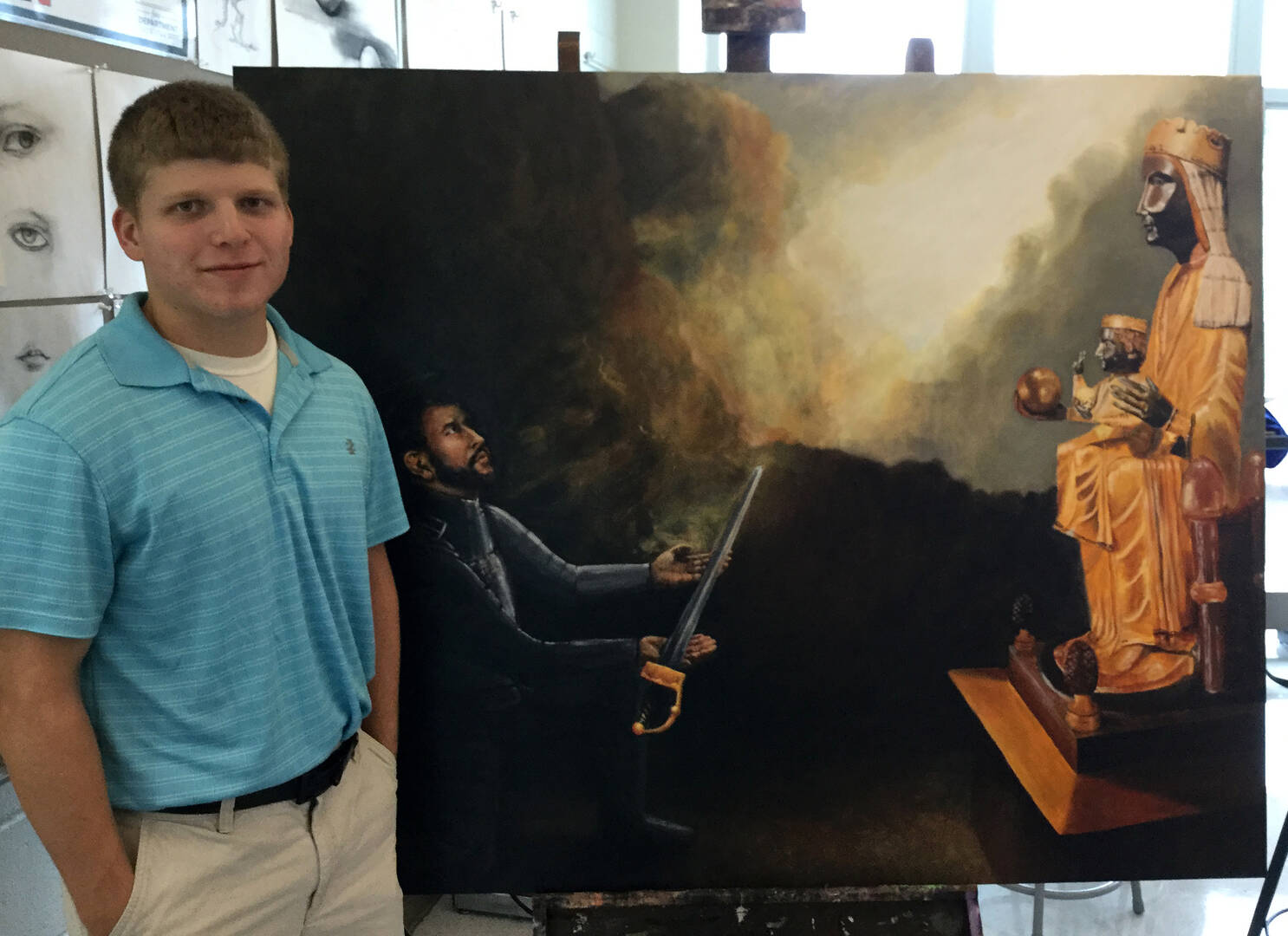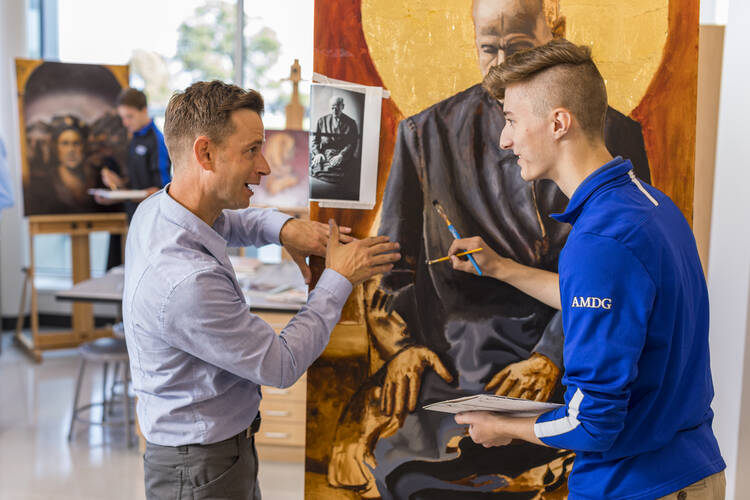When entering the Skinner Chapel at Creighton Preparatory School in Omaha, Neb., one could be forgiven for mistaking the bright, modern space for a gallery in a world-class art museum. The artwork adorning the pristine white walls evinces a masterful use of light and shadow, much of it in the style of the master painter Caravaggio, the Italian Baroque artist renowned for his intensely realistic and dramatic religious scenes.
What makes this collection remarkable, though, is that while each piece showcases prodigious painting prowess, none were created by a professional artist. Instead, each one has emerged from the prayerful imagination and painstakingly measured brushstrokes of the high school’s own students.
“We have students here that are that good, that could paint them!” Jeremy Caniglia said when the school’s president, Thomas W. Neitzke, S.J., asked for his advice on buying a set of Stations of the Cross for the school’s newly renovated chapel in 2016.
With the green light from the president, Mr. Caniglia turned to Irving Delgado-Arellanes, a senior student, to take on the creative challenge. “He laid out all 14 stations,” Mr. Caniglia told America in an interview at the school’s atelier this spring. Mr. Delgado-Arellanes excelled, earning second place at the national Scholastic Art & Writing Awards.

“It was the first religious piece we ever had to go to the nationals,” Mr. Caniglia said, pointing out that it was unusual for religious art to get such acclaim in a secular competition. Emboldened by the success of this student’s first commission, Mr. Caniglia set out to deliver on even bolder plans.
“There was an original plan in the 1950s to have each of those side altars with the Jesuit saints. Some were about mission, some were about education,” Mr. Caniglia said, recalling a later conversation with Father Nietzke at the school. “So we were going over that and I said, ‘We could paint these—the students could, if they work in groups of six,’” he added, a gentle smile spreading across his face. “So we started that program up and it was just really inspiring.”
Before he could continue, Mr. Caniglia had something deeper he needed to share. Proud of his Sicilian roots, he wanted to point out his ancestral connection to the bedrock of Jesuit education in Messina, Sicily, where 10 members of the Society of Jesus opened the first Jesuit school in 1548. “I have this love and care, and understanding of a lot of the traditions,” Mr. Caniglia said. “One of them that I fell in love with was the composition of place from Ignatius’ Spiritual Exercises.”
It appears this is the force behind this art teacher’s success in the classroom. “It’s hard because you get these young men in here and some are really spiritual, religious, [but] some never tackled, never understood any of that,” he explained. “I had one student who was not religious at all. He did the first [painting of] Ignatius for us.”

Mr. Caniglia replayed the kind of conversation he has when introducing this facet of Ignatian prayer and contemplation as a technique his students can employ when conceiving new artwork in the classroom. “I tried to explain it like this to them: ‘You see method actors that you guys love. You guys love [them] on screen because they become the part.’”
Then he encourages students to imagine themselves as the characters in Bible stories—even becoming Jesus—as Ignatius did, to draw spiritual insights and creative inspiration for their paintings. “If you’re reading the Gospels and you could picture yourself for a minute as Mary watching her son die, trying to be the mother, put on a strong face for your son who’s going on this spiritual path of sorrow,” he said. “And then you’re looking at the son looking at the mother; he looks at his mom and he’s got to put on his best face.”
“When we talk about the stories, they become more real. Students start thinking, ‘The saints are really cool,’” he said. “I think they see that, and they’re more influenced, and it kind of pulls them in.”
Creighton Prep’s 34th president, Matthew C. Spotts, S.J., agrees. “The arts are crucial to Jesuit education,” he said when asked to comment on the school’s artistic heritage. “Our arts programs are a home for students at Creighton Prep, but they also inspire the expansion of heart and imagination—elements that are indispensable to Ignatian practice.”
Art and Perseverance
Nic Thurman’s first year at Creighton Prep took a surprising turn when a friend’s invitation to the school’s art studio sparked a passion for art and painting. “The world has no idea the amount of perseverance it takes to succeed in art,” Mr. Caniglia told Omaha Magazine earlier this year. “But I saw that in Nic before he was even in my class.”
A year later, Mr. Caniglia encouraged Nic, now his student, to paint a pivotal scene from St. Ignatius Loyola’s early life, the moment when he decided to renounce his military aspirations and become “a soldier for Christ.”
“I don’t understand this Ignatius. Why do you want me to do this painting?” Mr. Caniglia recalled Nic asking. His response: “Nic, you have so much in common with this guy; he got hit by a cannonball.”

The teacher explained the connection: “You were on the football field your sophomore year,” he remembers telling his state-record-holding, powerlifting student. “You got hit at a Millard North game.”
The accident crushed his student’s knee, according to Mr. Caniglia. “He can’t play football ever again,” he said. “And he can barely powerlift.”
“Ignatius had to rethink his whole life,” Mr. Caniglia said. “And Nic did the same thing. He’s like: ‘I want to go into the arts.’” Telling the story with excitement, Mr. Caniglia clenched the table he was standing behind. “Over Christmas break, he came up with that scene [of St. Ignatius], which from a 16- to 17-year-old student, I was like, ‘This is amazing!”
Mr. Caniglia identified deeply with his student’s story. An alumnus of Creighton Prep himself, he recalls his parents wanting him to play the saxophone in the school band, but he was “terrible” at it. Fortunately, his band teacher agreed and suggested he take an art course.
“Could you draw this? Could you do this?” Bob Willits, the art teacher, asked him. “And I had a knack for it,” Mr. Caniglia recalled. “I loved seeing something invisible become visible in front of me. And from that day, it’s never changed. I get so excited when I do a piece.”
Mr. Caniglia’s passion and talent for art only grew stronger after high school. He pursued his dream of being an artist through scholarships, first at Iowa State University and then at the prestigious Maryland Institute College of Art, where he earned a master’s degree in fine arts. This led to artistic residencies in New York and later in Norway, where he studied under the renowned Norwegian master painter Odd Nerdrum. “He’s like one of the last old masters. He paints like Caravaggio,” Mr. Caniglia said. “He only takes three students a year from around the world.”
Today, Jeremy Caniglia’s artwork is exhibited internationally, showcasing his mastery of religious and classical themes. He is also a sought-after illustrator for the book covers and pages of many best-selling fiction authors, including Stephen King, Max Brooks and Charles Dickens. His diverse portfolio also spans art for movies, magazines, comics and concept art for Showtime’s “Masters of Horror” series.
Aside from his artistic accomplishments, Mr. Caniglia is a family man and outdoor enthusiast. He has a wife, Jacqui, and two children, Vivian and the aptly named Caravaggio. Mr. Caniglia explores the mountains—hiking, bouldering or biking—and tends to his native bees and garden. After teaching at Creighton University, he joined Creighton Prep, earned a master’s in secondary education, and was recognized as one of eight secondary educators of the year in the Archdiocese of Omaha in 2022.

In 2017, Mr. Thurman traced the contours of his teacher’s creative path when he was chosen as Odd Nerdrum’s youngest-ever apprentice. Fresh out of high school and just 18 years old, he embarked on a three-year residency at the Nerdrum School in Sweden, where he mastered his technique and carried forward the artistic legacy born and nurtured in him at Creighton Prep.
Mr. Thurman is but one of Mr. Caniglia’s student success stories in the fine arts world. Another student, Gannon McMullen, who worked on the painting of St. Francis Xavier in the school chapel, is presently studying at the Grand Central Atelier in Queens, N.Y.—which is, Mr. Caniglia said, “the top school in the United States for Renaissance-style painting.”
Hunter Parry, who painted the portrait of St. Aloysius Gonzaga that also hangs in the Skinner Chapel, went on to study at the Florence Academy of Art. “They only take 24 students around the world,” Mr. Caniglia said.
After his first year in Florence, Mr. Parry visited Mr. Caniglia at Creighton Prep. “I asked how he was doing,” the teacher recalled, “and he replied, ‘I find myself going into the churches and I sit, and I’m thankful for everything we did at Prep.’” Mr. Caniglia paused. “That was huge for me,” he said, fighting back tears.
The teacher continued to recount the conversation, which had unfolded in the student chapel as they stood before the painting of St. Aloysius Gonzaga that Mr. Parry had worked on. “I didn’t understand it at the time. I didn’t know what we were doing,” said Mr. Caniglia, recalling Mr. Parry’s words to him. “Now I get it; when I sit and look at those paintings and what they mean, and what they mean to someone who’s devoted, or has a prayer life, I have that now. I sit there and I find the same solace, reflection.”
Encounters like these give meaning to this teacher’s life. “I find myself giving as much time as I can because I feel like that’s why I’m here. That’s my purpose: to just inspire,” Mr. Caniglia said. “I feel like they’re a part of me, in different ways, and they’re going to do amazing things. I just want to pay it forward, with cura personalis, and try to reach them and know there’s great things in this world. It’s not all gloom and doom; there’s so much opportunity for them.”







